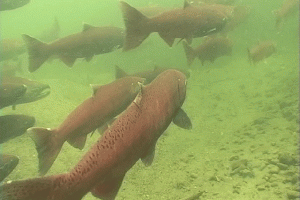Research in Chinook Run Timing
The relatively mild winter of 2014 – 2015 has made predicting the return of Chinook salmon difficult, but the forecast is for an average to slightly late run of Chinook salmon to the Yukon River. Scientists are estimating the first significant pulse (15% point) of Chinook to cross the delta around June 15, and the half-way point (50%) of the run to be reached around June 23. This forecast could change if the run looks significantly different than the model. For more information contact phil.mundy@noaa.gov.
A partnership to predict run timing
Researchers from NOAA Fisheries and the Alaska Department of Fish and Game, with the support of the Alaska Ocean Observing System, have identified a combination of spring conditions that is closely related to the timing of Chinook salmon on the Yukon delta. Using percent spring ice cover between St. Lawrence Island and the Yukon delta, April air temperatures in Nome, and marine surface temperatures just offshore of the delta in May, the team predicted the timing of the run in the last two seasons to within three days of the actual timing before the start of each run.
Click here for a summary of historical and near real-time fish and environmental data for the 2015 Chinook salmon run in the Yukon River delta, Alaska Department of Fish and Game (ADF&G) Management Area Y-1.
Why is it so important to get the run timing right?
Known for navigating the longest annual freshwater migration route of any salmon to reach their spawning grounds, Chinook salmon can start arriving on the Yukon River delta at almost any point in June. Over the past 50 years the first pulse of Chinook has occurred sometime between June 6 and June 26. Traditional knowledge on the Yukon holds that spring weather conditions, including ice, temperatures and wind determine when in June the fish enter the river, but each spring brings a different combination of conditions, so pinning down a schedule for the arrival of the first pulse can be tricky. Twenty days can be a long time to wait to find out when the fish are actually coming and if there are enough of them to harvest.
Management of the Chinook salmon fishery is closely linked to expected time of arrival in harvest areas. When the migration begins earlier than expected, it’s reasonable for fishery managers to conclude that the run is stronger than it actually is, possibly resulting in over-harvesting near the river’s mouth and loss of harvest opportunities upriver. Likewise, in years when the first pulse of fish comes late, it is reasonable for fishery managers to conclude that the run is very weak, perhaps so weak that fishing needs to be slowed or stopped altogether.
-
Photograph by Deborah Mercy
-
Photograph by Deborah Mercy
-
Photograph by Deborah Mercy




